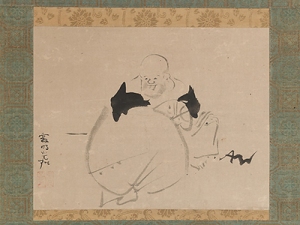
Hotei, Japan, After Kenkō Shokei (Japanese, active ca. 1470–after 1523), © Metropolitan Museum of Art
Pu-tai (Chinese), Hotei (Japanese) literally means ‘hempen sack’. He was said to have been a Chinese monk who lived in the tenth century. His name comes from his wandering through the towns with a hempen beggar’s sack on his back. Countless stories are associated with Pu-tai. They depict him as a wonder-working eccentric in whose actions the mind of Ch’an (Zen) is expressed. Only at the time of his death did he reveal his true identity as an incarnation of the future buddha Maitreya. In Chinese monasteries he is represented as the Laughing Buddha. Pu-tai is the embodiment of the ideal of Ch’an Buddhism as represented in the Ten Oxherding Pictures (Ju-gyu-no-zu).
Pu-tai whose real name was Ch’i-tz’u, lived in what is now the province of Chekiang. He was highly regarded by the people, since he could predict the weather. If he went to sleep on a bridge or on the street, one could expect good weather. On the other hand, if he wore sandals and looked for shelter, one could count on rain.
His character showed the love of paradox that is typical of Ch’an. To the question how old he was, for example, he would answer, ‘As old as space.’ Once when he was in the middle of the marketplace someone asked him what he was doing there. He answered, ‘I’m looking for people.’ His person was also surrounded by a sense of the miraculous. He could sleep while snow was falling and no snow would land on him. The pronouncement he made, according to tradition, at the time of his death, revealed his identity as an incarnation of the buddha Maitreya:
Maitreya, truly Maitreya,
Countless times reborn,
From time to time appearing among men,
But by the men of the time unrecognised.
He is said to have reappeared after his death in other parts of China. Gradually monks and laymen, aware of his popularity among the people, began to make pictures of the monk with the hempen sack. The figure of the Laughing Buddha developed out of this. This figure is to be found today in every Chinese monastery.
[From: The Rider Encyclopaedia of Eastern Philosophy and Religion, 1999, Rider.]

Hotei, Japan, Ogata Kōrin (Japanese, 1658–1716) © Metropolitan Museum of Art
Hotei (Chinese: Budai) is one of the most beloved characters of Zen Buddhism and is believed to be an avatar of Maitreya, the Buddha of the Future. Potbellied with a shaven head, this cheerful, blissful monk is said to have roamed the countryside in the late ninth to early tenth century in the area of Mount Siming, in southern China, carrying his few belongings in a patched cloth bag.
Hotei was probably first portrayed in painting soon after his death and later entered the folklore of China and Japan as one of the Seven Gods of Good Fortune (Shichi fukujin). In his ink paintings of august East Asian mythological and historical personages, Ogata Kōrin often portrayed the seven gods in a more playful aspect, as seen here.
The Metropolitan Museum of Art
Hotei Pointing at the Moon The portly monk Hotei is shown hoisting his satchel over his shoulder while he points a finger at the sky above, toward an unseen moon. The abbreviated brushwork and suggestive use of blank space were earlier associated with Zen monk painters of medieval times. The Zen monk Fūgai Ekun of the Sōtō sect followed in this tradition, and often inscribed his paintings in a highly cursive script.
The inscription reads:
生涯不貧、大福無隣、 指月看月、途中老賓
Shōgai hin narazu
daifuku rin nashi
tsuki o sashi tsuki o miru
tochū no rōhin
Throughout my life, I haven’t been poor
Nor have lived amid wealth.
Pointing at the moon, looking at the moon,
I’m just an old traveler along the way.
—Trans. John T. Carpenter
The Metropolitan Museum of Art.
Click any image below for more images.
Categories: Art, Biography, Chan / Seon / Zen, Encyclopedia, History










Nice one, thank you.